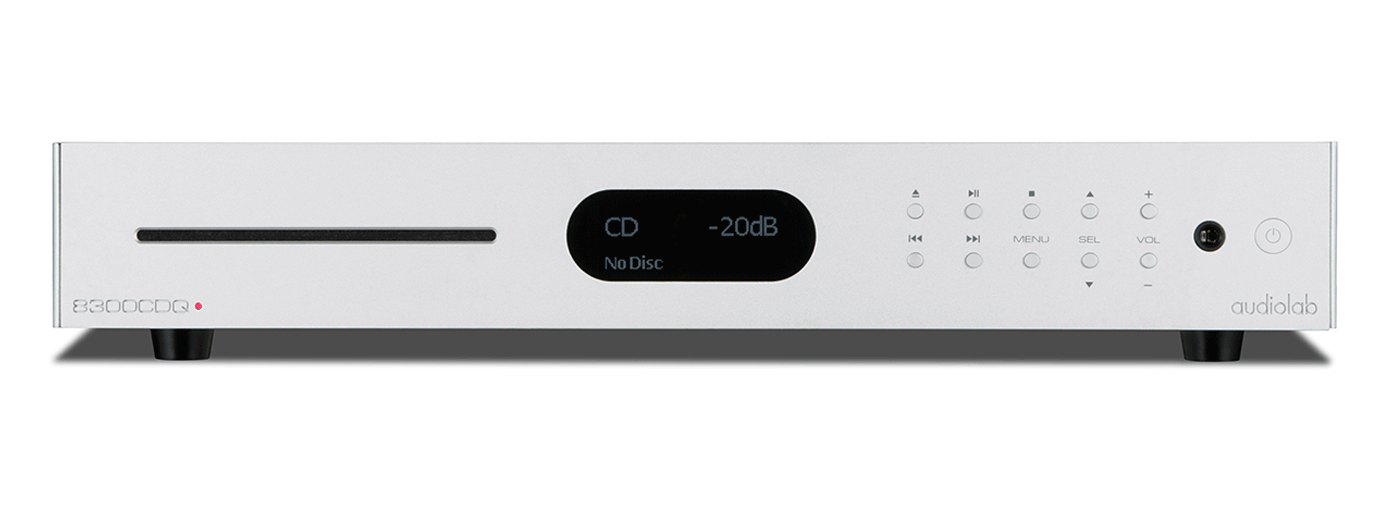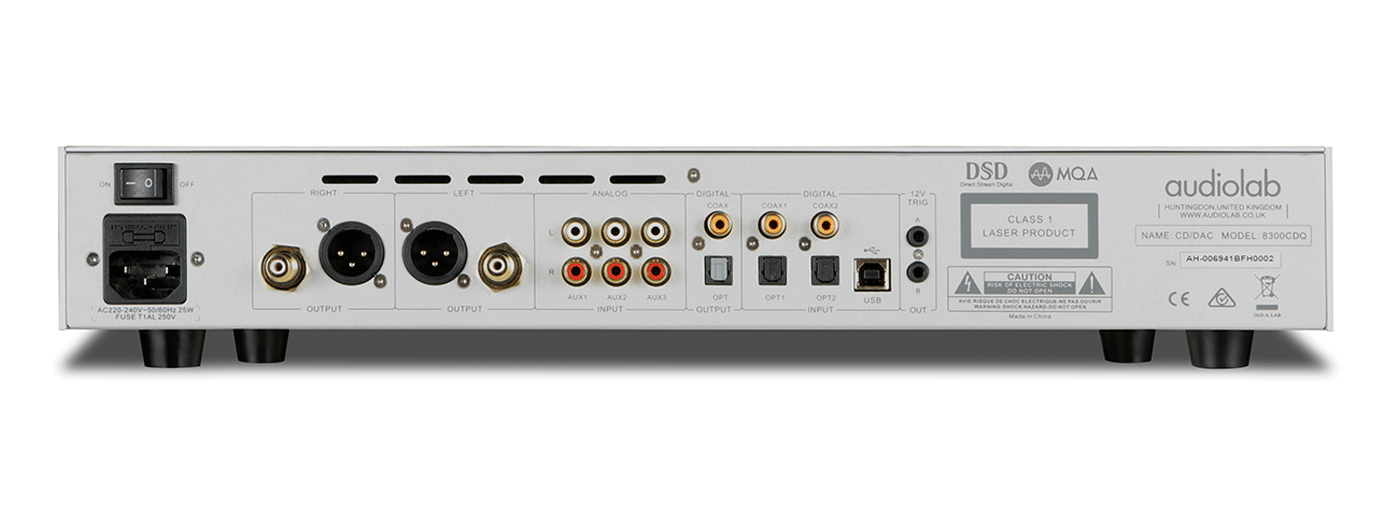We will notify you as soon as the product is in stock in our warehouse! The orders will be placed in priority order and we do not guarantee that the price will remain the same.
-
Free Shipping
-
6
Interest FreeInstalments
-
 2 Years Warranty
2 Years Warranty
-
Free Shipping
-
6
Interest FreeInstalments
-
 2 Years Warranty
2 Years Warranty

Audiolab's new 8300CDQ features high-quality analog preamp circuitry, combined with three stereo pairs of line RCA inputs for connecting analog sources. The preamp circuit is kept as simple as possible using high quality components to maintain signal purity, while line input signals are passed through a precision analog gain stage. Great effort has gone into the physical layout of the 8300CDQ's circuitry, protecting the sensitive preamp section from noise interference.
The Sound of Science
Audiolab's 8300CDQ adds further flexibility by incorporating a direct-coupled headphone amplifier with current feedback circuits. Accessible via a front 6.35mm jack, it ensures a dynamic, detailed and exciting performance with all types of headphones.
The key feature introduced in the 8300CDQ is MQA (Master Quality Authenticated) decoding. The brainchild of Meridian Audio co-founder Bob Stuart, MQA is a digital audio format designed for high-resolution music streaming and available via subscription to Tidal's 'HiFi' tier (among other sources). The 8300CDQ "unpacks" MQA data - received via the USB input - at full resolution of the original file and passes the signal through the DAC and preamplification stages, ready to feed a power amplifier or active speakers.
Audiolab's MQA decoding system was developed by John Westlake, one of Britain's leading digital audio experts. There are several ways to play MQA on audio devices, and not all of them produce the same audio result. Westlake's solution maximizes the potential of the format, just as the 8300CDQ's design draws the best sound quality from other audio codecs and, of course, CD.
- It was 2010 when the original Westlake-designed Audiolab CD players - the 8200CD and 8200CDQ - were launched and became world-renowned for their excellent sound quality and ease of use.
- In 2015, the 8300 series arrived and both 8200 series producers were replaced by the 8300CD, continuing the formidable reputation of its predecessors.
- A lot of research went into creating the improved 8300CDQ, further developing Audiolab's classic range of CD players to reach even greater heights.
In addition to the functions described above, the 8300CDQ is based on exemplary circuitry developed for the 8300CD, including:
• Slot-loading CD transport mechanism
Fast in operation and thoughtfully designed, the 8300CDQ's CD-load transport offers exceptional reliability. A digital buffer reduces disc read errors, allowing playback of scratched CDs that cannot be read by conventional mechanisms. High disc stability and low tuning sensitivity contribute to the 8300CDQ's excellent CD sound quality.
• High-resolution Digital Inputs
The five digital inputs include 1x asynchronous USB and 4x S/PDIF (2x coaxial and 2x optical). High-resolution digital audio is supported up to 32-bit/384kHz PCM and DSD256, and USB HID compatibility allows control from a connected PC, Mac or media player without a driver (driverless control).
• 32-bit ESS Saber DAC
CD transport and digital inputs feed the DAC section with an ESS Saber32 reference chip at its heart, using HyperStream architecture and ESS Technology's Time Domain Jitter Eliminator to deliver ultra-low noise and high dynamic range. No company knows more about getting the most out of this 32-bit, eight-channel hybrid multi-bit Delta-Sigma DAC than Audiolab. The 8200CD and 8200CDQ were among the first audio components to use it, and the company has improved its implementation ever since. The conversion process involves 512 DAC elements (256 per channel) each operating at 84.672MHz - all digital audio sources, regardless of sample rate, are reproduced or upscaled at this frequency.
• Exemplary Jitter Reduction
Around the DAC chip are extensive measures to reduce jitter (digital distortion) to extremely low levels. Careful circuitry and low-noise power supplies complement the patented Saber32 DAC and intelligent DPLL (Digital Phase Locked Loop) circuitry, radically reducing timing errors from all digital input sources.
• Time Domain Isolation
While the Saber32 sample rate converter virtually eliminates jitter in the digital domain, external interference in the "analog domain" caused by RFs, the PSU connection, and so on will affect the audio performance of the DAC. Audiolab solves this problem with the CATDA (Cascaded Asynchronous Time Domain Attenuator) circuit. To achieve the best possible performance, three identical stages are used - each individual stage provides increased isolation, thus maximizing timing performance, even at higher RF frequencies.
• Selectable Digital Filters
As digital audio reproduction technology has advanced, the importance of the characteristics of digital reconstruction filters has become more appreciated. The Audiolab 8300CDQ features seven user-selectable filters for PCM audio data (including CD) and four ultrasonic filters for DSD data. These settings allow the user to adjust the performance of the 8300CDQ according to the sound system, the quality of the digital file and personal taste.
• Discrete Class A Analogue stages and Sophisticated Power Supply
The 8300CDQ's analog outputs and power supply are extremely well built. The circuit includes a large low-noise toroidal transformer, a plethora of eservoir/smoothing capacitors, an impressive number of regulator chips, and discrete transistors (instead of op-amps) in the ultra-low-impedance analog output stages for driving any cable and load. The power supply incorporates 29 regulated supply rails.
- Display:
- POLED 128 x 64 pixels 2.7"
- Standby Feature:
- Yes
- 12V Trigger:
- Yes
- CD Mechanism:
- Slot-Loading
- DSD Compatible:
- Yes (DSD64 / DSD128 / DSD256)
- Disc Compatibility:
- CD/CDR
- DAC:
- ESS Sabre32 9018 chip
- Resolution:
- 32 bits
- Sampling Frequency:
- Optical, Coaxial, AES: 32kHz - 192kHz
- USB: 32kHz - 384kHz(PCM) / DSD64, DSD128, DSD256
- Maximum Sampling Frequency:
- Optical,Coaxial, AES: 192kHz
- USB: 384kHz (PCM) / 11.2M (DSD256)
- Output Voltage:
- 4.2Vrms ± 0.1 (Balanced)
- 2.1Vrms ± 0.1 (Unbalanced)
- Output Impedance:
- 10Ω
- Total Harmonic Distortion (THD):
- < 0.002% (1kHz, 0dB, 20Hz ~ 20kHz, A weighted)
- Frequency Response:
- 20Hz - 20kHz (± 0.2dB)
- Signal to Noise Ratio (S/N):
- < -100dB A Weighted (Balanced)
- < -98dB A Weighted (Unbalanced)
- Crosstalk (@1kHz):
- < -130dB (Balanced)
- < -120dB (Unbalanced)
- Standby Power Consumption:
- < 0.5W
- Power Requirements:
- 240V ~ 50 - 60Hz
- 230V ~ 50 - 60Hz
- 115V ~ 50 - 60Hz
- 100V ~ 50 - 60Hz
- Dimension (W x H x D):
- 444 x 80 x 317mm
- Carton Size ( W x H x D):
- 500 x 140 x 455mm
- Weight:
- 6.0kg (Net)
- 7.5kg (Gross)
How would you rate this product?
Stock Notice








